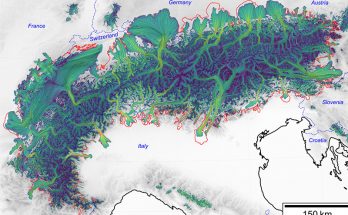Cette publication est également disponible en :
![]() Français
Français

In collaboration with an international team, an Institute of Earth Sciences researcher reveals the complexity of temperature evolution over the past 12,000 years.
To predict the future, we rely on climate models. But reducing the uncertainty of these models is a delicate matter. To do this, we need reliable data over long periods of time. This is why understanding the Earth’s climate history from the distant past is invaluable: it helps us project into the future. Changes in the Earth’s average surface temperature over the past 12,000 years (during the current interglacial period, the Holocene) have been the subject of much debate. Climate model simulations suggest a continuous warming since the beginning of the Holocene. Yet the most well-documented reconstructions suggest that the global average temperature was at a maximum about 6,000 years ago, and then the Earth cooled until the onset of the current climate crisis (at the time of the Industrial Revolution). This major discrepancy between models and past climate observations is called the “Holocene Temperature Conundrum”.
In this new study, scientists used the largest available database of past temperature reconstructions extending back 12,000 years to carefully investigate the geographic pattern of temperature change during the Holocene. The team finds that, contrary to previously thought, there is no globally synchronous warm period during the Holocene. Instead, the warmest temperatures are found at different times not only in different regions but also between the ocean and on land. This questions the relevance of comparing global mean reconstruction with model simulations at the crux of the Holocene conundrum.
According to the lead author Olivier Cartapanis, “the results challenge the paradigm of a Holocene Thermal Maximum occurring at the same time worldwide”. And, while the warmest temperature was reached between 4000 and 8000 years ago in western Europe and northern America, the surface ocean temperature cooled since about 10,000 years ago at mid-high latitudes and remained stable in the tropics. The regional variability in the timing of maximum temperature suggests that high latitude insolation and ice extent played major roles in driving climate changes throughout the Holocene.
For Samuel Jaccard, professor at Institute of Earth Sciences, these results highlight “a more nuanced climate variability with strong regional disparities over time”. He believes that “taking these regional specificities into consideration should be a priority for the development of climate models, in order to best guide the measures to be taken rapidly to mitigate the consequences of climate change”.
Thus these new elements present a clear target for climate models. Their ability to account for climate variations in space and time will increase the reliability of future climate change projections.
Bibliography
- Cartapanis O., Jonkers L., Moffa-Sanchez P., Jaccard S. L., De Vernal A. Complex spatio-temporal structure of the Holocene Thermal Maximum. Nature Communications.
doi.org/10.1038/s41467-022-33362-1



